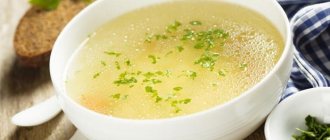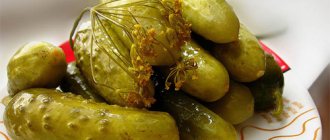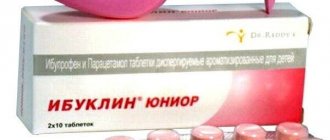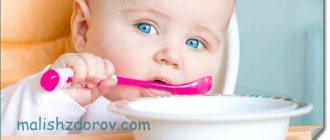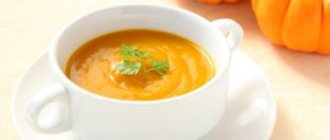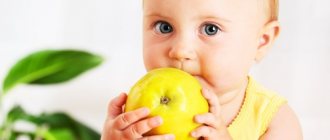Feeding a child is a problem for every mother. It is especially difficult for mothers of one-year-olds, who face the most difficult task of introducing the first complementary foods. What product should I start with, how should I offer it, what should I be wary of? Complex questions, the answers to which you have to find on your own, through trial and error. Despite the fact that each child reacts individually to new food and it is impossible to predict with 100% certainty, experts have identified a number of foods that are least likely to cause a negative reaction in one-year-old children. Rice for children is considered to be the most “harmless” among cereals. Let’s take a closer look at how to cook rice porridge for babies and what to watch out for.
Benefits of rice porridge
The main problem in choosing food for a baby lies in the characteristics of the baby’s intestines. The enzyme base of one-year-old children is incomplete. This means that the intestines are not able to process and absorb most substances. As a result, foods that the body is not able to digest cause disruptions in the digestive system - constipation, disorders, intestinal inflammation and severe allergic reactions.
Rice porridge is ideal for first feeding. Due to its starch-mucosal composition, it creates a film on the inner walls of the intestine. The receptors are not irritated, the available enzymes are sufficient for processing and assimilation. As a result, there are no disruptions in the digestive process.
The composition also plays an important role:
- gluten free;
- contains vitamins from group B and E - promotes keratinized tissue (nails and hair), has a benign effect on the nervous system;
- contains 8 types of amino acids, each of which is involved in the construction of the body;
- mainly consists of complex carbohydrates - they contribute to high-quality muscle mass building and replenishment of energy costs.
Which variety to choose for complementary feeding
Rice is divided into 3 categories based on appearance:
- Coarse grain. Rich in starch, used for casseroles, recommended for children over one year old;
- Medium grain. Absorbs a lot of water and boils well. Used for preparing pureed porridges. Recommended for babies up to one year old;
- Long grain. Does not boil over, there is no sticky mass. Suitable for crushing into flour. Suitable for use by children under one year of age in the form of flour.
Parboiled rice is rich in starch, which does not allow glucose to enter the blood in full. Unregulated consumption of this type of cereal is fraught with diabetes.
Brown rice is the healthiest, but it is difficult to digest - it can only be given to children after they are one year old.
How to cook rice porridge with milk for children
Mothers know that no matter how much you make this or that dish for adults, the children's menu has its own technology and recipe. The thing is that it’s difficult to please little picky eaters, and besides, all the ingredients must be combined correctly. In addition, you should adhere to the technological process so as not to harm the child’s body.
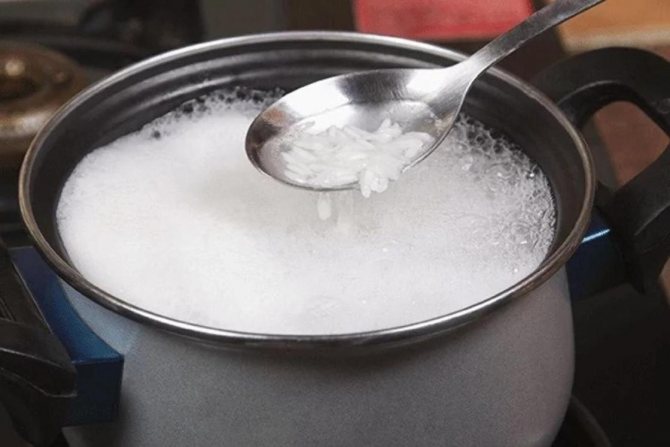
Therefore, the question of how to prepare rice porridge for a baby is relevant and important. To successfully complete this task, follow the algorithm:
- Rinse the cereal and fill it with cold water. Leave for 20 minutes.
- Pour purified water into the saucepan and bring it to a boil.
- Drain the water from the cereal. Place the rice in boiling and slightly salted water. Cook for 15 minutes, stirring constantly to prevent the grains from sticking together.
- Boil the milk and add it to the container where the rice is cooked. Add sugar. Cook for 10 minutes over low heat.
- Add butter to the porridge and stir.
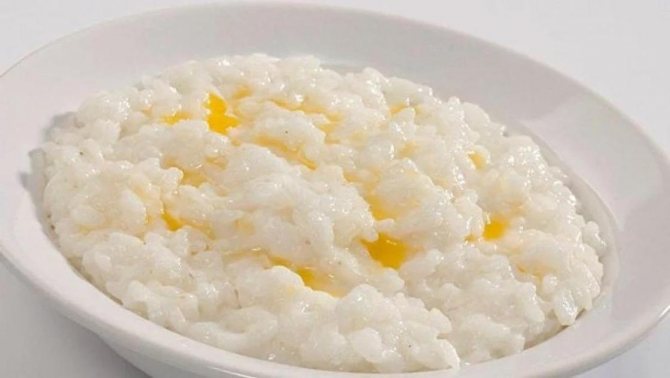
Serve the porridge warm to your child, preferably at lunch or in the morning, because the rice is a little strong and takes a long time to digest.
Milk rice porridge is an excellent complementary feeding option for babies up to one year old. Study the recipe presented and introduce it into your child’s diet.
How to introduce rice porridge into complementary foods
Any product is introduced into the infant’s diet according to the scheme “give for testing - monitor the reaction - feed, increasing the portion with each dose.” Rice is no exception.
Basic Rules:
- the first portion should not exceed half a teaspoon;
- always give a new product in the first half of the day;
- observe the body’s reaction for at least a day;
- if the reaction is positive, you cannot feed the bowl right away - start with 1-2 teaspoons and supplement with milk or formula, increase the portion gradually.
Sequencing:
- For the second meal, prepare rice porridge. It is difficult to feed complementary foods at the first appointment - the mother will not get enough sleep, wasting time on preparation, the baby will be capricious when asleep and is more likely to refuse;
- feed the baby porridge. Naturally, most of it will be spat out and smeared on your cheeks. It is necessary to ensure that a maximum of half a teaspoon gets into the intestines;
- supplement with milk;
- Do not give your child any other product for 24 hours, even if it has long been introduced into the diet. Feed only milk. This will allow you to track the body’s reaction exclusively to rice - the presence of allergies, constipation, the appearance of colic;
- if there is no negative reaction, take the next meal of rice porridge after 3-4 days, increasing the total amount of food consumed to one teaspoon;
- It is not recommended to feed your child 2 types of complementary foods per day for a month to avoid intestinal overload.
What are the benefits of rice for babies?
My daughter is atopic and we had a negative experience with children's instant porridge - it was sprinkled on dairy-free, low-allergenic buckwheat porridge, but there was no rash on regular buckwheat.
Now I want to introduce rice, but there is all sorts of it in stores: round, long-grain, steamed, polished, basmati, jasmine, rice flakes, brown, wild, etc.
Help me decide! Which rice is best for complementary feeding?
How to choose a rice variety
The benefits of rice porridge depend almost entirely on what kind of rice you choose to prepare it. First of all, you need to figure out how to choose rice for porridge, which variety is suitable and which is not.
The healthiest, of course, is brown rice, but it is not entirely suitable for porridge cooked in milk. The combination of rice shell (brown rice is brown rice) and milk can be bad for your stomach and cause serious upset. This problem can be easily solved by cooking rice porridge in water.
As for varieties, the following varieties are best suited for rice porridge:
Arborio is an Italian variety of rice; when cooked, it often absorbs the aroma and taste of other components of the dish, so it is better to cook it in water. More often it is round or medium grain.
Krasnodar - this variety of rice can most often be found on store shelves; it is ideal for cooking with milk.
Jasmine - Thailand is the birthplace of this long-grain rice; it is better to cook porridge from this rice in water. The only drawback of this variety is that when cooked, the grains stick together strongly, forming a thick mass.
These varieties of rice are best suited for cooking rice porridge, but in no case should you take these as strict rules, only as recommendations. You can choose any type of rice for porridge, focusing on your own preferences.
Rice is one of the oldest grain crops. It is most common in the East, but has also gained recognition in Europe due to its nutritional value and beneficial properties. Rice porridge for infants is one of the best options for first feeding.
Properties of rice cereal
The unique properties of rice are a secret that lies in the composition of the grains. High nutritional value makes cereal indispensable for baby food.
Table - Composition of rice cereal, per 100 g
VitaminsWeightMineralsWeight
| B vitamins | 36 mg | Silicon | 1250 mg |
| Vitamin E | 0.5 mg | Phosphorus | 320 mg |
| Vitamin PP | 4 mg | Potassium | 200 mg |
| Vitamin H | 1 mg | Magnesium | 95 mg |
| Calcium | 66 mg | ||
| Iodine | 1.5 mg | ||
| Magnesium | 50 mg | ||
| Iron | 1 mg |
The beneficial properties of rice were noticed a long time ago and today they are actively used in children's and dietary nutrition.
Rice porridge for children can be harmful to health if you prepare it from low-quality grains or feed it daily to your baby.
Congee
Rice water for infants cannot serve as a separate type of complementary food. It is used only for stomach disorders as a binder. The decoction not only allows you to restore digestion, but also saturates and strengthens the body.
The mucous liquid envelops the walls of the stomach and prevents pathogenic bacteria from affecting them. This property of the decoction allows you to bring the gastrointestinal tract back to normal within a day (in the absence of intestinal infections).
The prepared and cooled liquid is offered to children in a volume of 50-100 ml (depending on age) 3-4 times a day.
Pour one and a half tablespoons of rice with cold water and leave for a while until the rice swells.
- Boil half a liter of water.
- Place rice in boiling water.
- Cook, stirring, over low heat for 40 minutes.
- Remove the broth from the heat and leave for 2-3 hours.
- Strain through thick cheesecloth or a sieve.
Rice porridge recipes
Rice porridge for newborns up to one year should be prepared with water or with a small addition of breast or baby milk. A month after introducing rice porridge into the diet, you can add 5 g of butter or vegetable oil.
After a year, milk can be diluted in half with water, and berries, fruits or jam can be added to the dish if desired. The calorie content of 100 g of ready-made porridge cooked in water is 80 kcal, milk contains 120 kcal.
It is best to start complementary feeding with 5% rice porridge or use ready-made instant dry formulas based on rice flour.
- Prepare rice flour by grinding the grains in a blender or coffee grinder.
- 5 g flour (flat teaspoon) and pour 100 ml cold water.
- Cook, stirring, over low heat for 20 minutes.
- Cool. You can add breast milk.
- Rinse half a glass of round rice and add a glass of water.
- Place on fire and boil.
- After boiling, cook for another 15 minutes. The grains should increase in size and boil.
- Pour in a glass of milk and stir.
- Cook over low heat for 10-15 minutes, stirring constantly, until the porridge becomes thick.
- Turn off the heat, cover the porridge and leave for 10 minutes. You can put the pan in a water bath for this time.
- Place a portion of porridge for a child in a sieve and mash it, pressing lightly with a spoon.
- Remove the pureed porridge from the back of the sieve.
- If the porridge turns out thick, dilute it with boiled water or breast milk.
Puree rice porridge can be prepared according to another recipe.
- Boil a glass of water.
- Add 1.5 tablespoons of rice.
- Grind the finished rice using a sieve or blender.
- Add 0.5 cups of hot milk and cook for another 5 minutes, stirring continuously.
- Remove from heat. If desired, you can add a spoonful of fructose and butter.
The use of rice in a child’s menu should be strictly dosed, otherwise you may encounter a large number of health problems for the baby. Alternate rice porridge with other grains; for children after one year, add fruits and berries, prepare rice-based soups and side dishes for meat. This approach to organizing a child’s diet will ensure an optimal supply of nutrients.
Rice cereal is so safe that porridge made from it is often recommended for a baby’s first feeding. Are there any benefits to white grains?
Source: Burda Media
Rice porridge, steamed with buckwheat, does not contain gluten, which is common in many other cereals: semolina, wheat, oatmeal, all porridges made from wheat derivatives - bulgur, couscous, artek, etc.
Gluten is strictly contraindicated for those suffering from gluten intolerance, a rather rare disease called celiac disease.
In addition, in recent years, pediatricians have noticed that children's gastrointestinal tract quite often cannot cope with gluten due to insufficient production of the necessary enzymes. This temporary intolerance manifests itself as abdominal pain, diarrhea, and allergic rashes.
Which rice to choose for a child
The main valuable substances, almost all vitamins and minerals are contained in a thin layer between the grain itself and the hard, inedible protective skin, which is removed during the initial processing of the grain.
The thin husk, the so-called bran, is subsequently used as fertilizer, bird feed and nutritional supplements for adults.
Thus, polished rice, and this is how the husk is removed, contains an order of magnitude less micronutrients than unpeeled rice.
In theory, the healthiest rice is unpolished, however, in addition to vitamins and minerals, bran contains a fairly large amount of fiber, which is not very good for the little ones.
As a kind of compromise, a method was invented that made it possible to make rice beautiful without depriving it of nutrients.
The grains, cleared of the upper hard layer, are treated with steam, and only after that they are freed from bran - thus, most of the minerals and vitamins go into the grain itself.
Steamed rice cooks quickly and practically does not stick together, but it is hardly suitable for small children; here you should consult a doctor whom you trust.
Why is rice good for a child?
- Rice porridge is an ideal source of energy that will support a child for several hours.
- The presence of starch, which turns into a decoction during cooking, helps the absorption of fiber, creating a protective film on the gastrointestinal mucosa.
- Rice grain contains dietary fiber necessary for intestinal microflora, but there is so little of it that rice is much easier to digest than other cereals.
- Due to the minimal amount of fiber and the complete absence of gluten protein, one-ingredient rice porridge is recommended as the first complementary food for thin babies.
- For older children, rice will help maintain energy, and in combination with dried fruits, honey, milk, it will help absorb vitamins and minerals.
- Despite the presence of potassium and fiber, rice, and especially its broth, inhibits intestinal motility, which will help with diarrhea, but not very good if you are prone to constipation.
The editors' opinion may not coincide with the opinion of the author of the article.
Source: https://rody-beremennost.ru/voprosy/chem-polezen-ris-dlya-grudnichkov
How to cook porridge for babies
Any food in the diet of a one-year-old baby should be served in the form of purees. The easiest option is to dilute purchased flour, crushed into flour.
Advantages:
- quick cooking;
- balanced composition, rich in nutrients;
- Liquid milk porridge is convenient to drink from a bottle.
Flaws:
- for families with average and low incomes - expensive;
- open packaging can be stored for no longer than 4 weeks - at first, more than half of the porridge will go into the trash.
In order to save money, porridges are prepared independently using whole grains. There are 2 “technologies”:
- prepare whole grains and grind them with a spoon/process them with a blender;
- Grind the raw cereal into flour in a coffee grinder.
Rice recipes for children
Baby porridge must have a uniform consistency, without large lumps, to make it easier to swallow. Most often, rice porridge for children is prepared with milk, without adding sweeteners. Dishes can be supplemented with fruits and boiled vegetables - this diversifies the diet and changes the taste, preventing the baby from getting used to the taste.
Rice porridge with milk
The recipe is available in two interpretations: flour and whole grain.
Three types of milk are used: breast milk, cow milk, and formula for artificial feeding.
Mother's milk is the healthiest, but it is not always possible to strain the required amount. Cow's milk is fatty and can cause allergies. The ideal option is to use mixtures for IV:
- a balanced composition is useful for the baby;
- the fact that the mixture is served with porridge from a spoon will not cause addiction in the child;
- when preparing porridge, the mixture is no different from cow's milk - no clots, no strange lumps, the porridge is soaked and boiled normally.
Flour porridge:
- pour milk into the flour;
- Boil for a few minutes over low heat;
- test for readiness;
- do not salt, do not sweeten.
Whole grain porridge:
- cook the cereal until it is fully cooked;
- do not salt, do not sweeten;
- Rub the warm porridge through a fine sieve with a spoon until it becomes a homogeneous liquid mass. You may need to wipe several times. An alternative is to grind it in a blender.
Porridge without milk
Cheap and hypoallergenic dairy-free rice porridge is an alternative to dairy. The cooking recipe differs in that water is added instead of milk.
Rice porridge in a slow cooker
The multicooker retains a greater amount of nutrients in the dish, does not require constant monitoring of the cooking process, and the finished dish turns out to be very tender.
- in accordance with the instructions for the multicooker, strict proportions of rice cereal and liquid (water, milk) are poured into the bowl;
- press the corresponding button – “rice” / “porridge”;
- Grind the finished dish through a strainer or grind in a blender.
Water porridge made from rice flour
If a mother wants to feed her child rice flour porridge with water, it is better to use store-bought products. It is aromatic, pleasant to children's taste, enriched with vitamins and minerals, some types contain crushed dried fruits.
Rice porridge without milk made from homemade flour is not as tasty as store-bought. Water is actually tasteless. The combination of these products will please the child least of all.
It is enough to dilute store-bought products with boiled water to the desired consistency.
It is recommended to boil homemade flour for several minutes over low heat and be sure to test for doneness. Do not add salt, replace sugar with glucose.
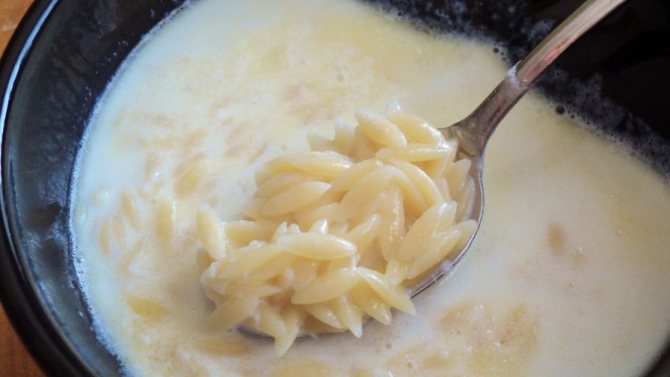
Puree milk soup for a 1 year old child
Milk soup differs from milk porridge in thickness - it is more liquid, and not only one type of cereal is added to it, but also a vegetable. Milk soup made from rice and cauliflower.
Ingredients:
- 1 tablespoon rice;
- 1 tablespoon of small cabbage inflorescences;
- water;
- one glass of milk;
- if necessary - butter.
Preparation:
- rinse the rice;
- wash the cabbage, separate the inflorescences from the stems;
- divide the inflorescences into small bunches;
- cook the inflorescences in a separate saucepan;
- Pour cold water over the rice and cook until completely cooked;
- mix boiled rice and inflorescences and grind until a homogeneous mass is formed;
- pour a glass of milk into the resulting puree and bring to a boil;
- Add no more than 1 teaspoon of butter to the plate.
Cauliflower can be replaced with zucchini for variety.
Congee
It is used for disorders of the digestive tract to normalize stool.
- 1 tbsp. Rinse whole rice grains thoroughly with cold water;
- pour into a saucepan, add 1.5-2 cups of water;
- boil and cook covered over low heat for an hour. If necessary, add water to prevent the rice from burning;
- When ready, strain, draining the liquid into a separate container.
Rice casserole
A dish for older children who are able to chew food from lumps.
Ingredients:
- rice - half a glass;
- bananas – 2 pieces;
- milk - one glass.
Cooking sequence:
- wash the rice until the water is clear;
- pour the rice into a saucepan, add water in a ratio of 1:3, pour in the milk and cook the cereal until fully cooked;
- Bring bananas to a pulp - mash with a spoon/fork or grind with a blender;
- grease the baking dish with butter;
- mix mashed bananas and rice porridge;
- You can add whole pieces of fruit to the mixture;
- Bake in the oven at 200 degrees until done (about 20 minutes).
Rice porridge with pumpkin
For babies who are unable to chew large pieces, pureed porridge is prepared.
Cook milk rice porridge separately, and pumpkin separately. The vegetables and rice are ground through a sieve until pureed and mixed.
Children who are accustomed to new food can cook porridge with lumps.
Rice and pumpkin pieces are boiled together in milk. When ready, everything is crushed with a fork in a plate until a mass with uneven lumps is formed.
If the mother is overcome by a great desire to sweeten the porridge, it is recommended to use glucose instead of sugar, but it is not recommended to sweeten milk porridges for children under 1.5 years old. Their taste buds are completely satisfied by the natural sweetness of milk.
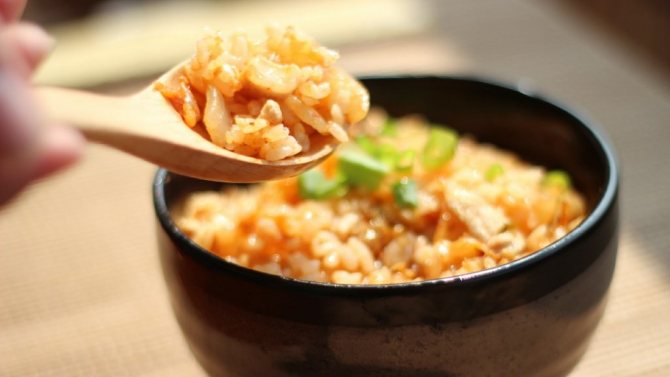
Pilaf with vegetables for children 1-2 years old
The pilaf recipe for children differs from that for adults in the presence of meat and spices. It is strictly forbidden to add fatty meat (pork, lamb, beef) and spices, in addition to bay leaves and salt, to children's pilaf. You can prepare pilaf from dietary poultry meat - turkey and chicken, but the child will not eat it. Without teeth, chewing meat fibers is very difficult. In practice, many children refuse to eat whole meat until school, since they cannot chew it completely and are afraid. Pilaf with meat is useful because when fried and stewed, the meat releases all its beneficial substances into the dish, like into a broth. Even if the baby does not eat a single piece of meat, he will benefit from it as part of the dish.
Ingredients:
- turkey or chicken fillet – 200 g;
- rice for pilaf – 1⁄2 cup;
- carrots – 1 piece;
- green peas – 1-2 tbsp;
- onion – 1 medium onion;
- broccoli.
Preparation:
- cut the meat into cubes and fry in a Dutch oven or in a slow cooker in the frying/baking mode until white;
- grate the carrots on a coarse grater, finely chop the onion;
- add carrots and onions to the meat, gild the vegetables;
- reduce heat, turn off frying/baking mode;
- add rice thoroughly washed with cold water, distribute the cereal evenly throughout the container;
- pour the remaining vegetables on top, distribute evenly over the cereal without mixing;
- carefully pour water - the liquid level should be at least 2 cm above the level of the vegetables;
- add salt to taste, cover with a lid and leave to simmer until done. Set the multicooker to pilaf/rice mode;
- Once ready, if desired, you can add 1 bay leaf and cover with a lid for 5 minutes.
Rice porridge with pumpkin for children
Another type of complex dish with vegetables is rice porridge with pumpkin for a child. As in the case of buckwheat, pumpkin porridge with rice for a child is ideal for a child’s body. Dietary and other beneficial properties make it possible to include it in the diet from a very early age. Experts advise alternating such dishes with soups and vegetable purees.
Pumpkin porridge for a 2-year-old child belongs to the category of dishes that must be included in the diet. In order to prepare it at home you will need the following products.
- chopped rice - ½ cup;
- 1.5 tbsp. milk;
- 0.5 kg pumpkin;
- 15 gr. butter;
Sugar and salt are necessarily added, but their quantity is determined by mothers independently, based on their own considerations. Initially, the chopped vegetable is poured with water and boiled for 10 minutes. As soon as it becomes noticeable that the pieces are starting to boil, add milk. The washed rice is also placed here, not forgetting to mix in the liquid. The dish is finished cooking over minimal heat, so that the porridge simmers. When the rice is ready, the dish is considered ready, oil is added to it and, dividing into portions, the children are fed.
Contraindications
Everything has its drawbacks:
- the rice is strengthening. It should not be used by children with constipation or hard stools;
- It is forbidden to give for intestinal colic;
- phytic acid does not allow calcium and iron to be completely absorbed;
- whole grains from abroad are subjected to chemical treatment in order to destroy parasites and preserve their marketable appearance. The chemical is absorbed into the grain and absorbed by the intestines.
Taking into account the disadvantages, it is recommended to give rice porridge to infants no more than 2 times a week. Breaks of 3-4 days will not allow constipation to form, the loss of calcium and iron will be insignificant, the body will absorb the necessary portion of amino acids, and the intestines will gently begin to get used to the new food.
Rice is hypoallergenic. Allergy to rice in a child occurs in one case - congenital indigestion of fiber. The diagnosis is made exclusively by a specialist after a series of tests.
